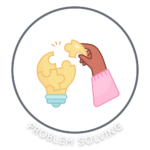
Problem-solving skills are essential — they empower students to navigate the challenges they encounter throughout their academic and personal lives. While it may seem like a complex concept for elementary students, fostering these skills from a young age is crucial for their cognitive development and future success. In this blog post, we’ll explore the significance of teaching problem solving to elementary students and provide a comprehensive lesson plan that educators can implement in their classrooms.
Understanding the Role of Problem-Solving Skills
Problem-solving skills include critical thinking, creativity, decision-making, and perseverance. These skills enable students to analyze situations, identify solutions, and implement effective strategies to overcome obstacles. By nurturing these skills early on, we as educators lay the foundation for students to become resilient, resourceful, and adaptable individuals.
Teaching problem solving to elementary students is vital for several reasons:
- Cognitive Development: Engaging in problem-solving activities stimulates children’s cognitive abilities, enhancing their logical reasoning and analytical thinking skills.
- Life Skills: Problem-solving skills are not only applicable in academic settings but also in everyday life. Teaching these skills equips students with the tools they need to tackle challenges in various contexts.
- Confidence Building: Successfully solving problems boosts students’ confidence and self-esteem.
- Collaboration: Problem-solving often involves working collaboratively with peers, fostering communication, teamwork, and empathy among students.
Lesson Plan for Elementary Students
Warm-up Activity (10 minutes)
To kickstart the lesson, engage students in a fun and interactive warm-up activity to stimulate their critical thinking skills. For example, present them with riddles, puzzles, or brain teasers that encourage them to think creatively and analytically:
“Sarah’s mother has three children. The first child is named April, the second child is named May. What is the name of the third child?”
This brain teaser encourages elementary students to think creatively and analytically. While the names “April” and “May” might lead students to think of the third child’s name as “June,” the correct answer is “Sarah,” as stated in the beginning of the riddle. This puzzle challenges students to carefully read and consider all the information provided before reaching a conclusion.
Introduction (15 minutes)
Introduce students to the concept of problem-solving and its importance in their daily lives. Discuss the steps, such as identifying the problem, brainstorming possible solutions, evaluating alternatives, and implementing a plan. Use age-appropriate examples and real-life scenarios. For example:
Imagine you’re at recess, and you and your friends want to play a game, but you can’t decide which one to choose. This is where problem-solving skills come into play. You need to think critically about each game option, considering factors like the number of players, the space available, and everyone’s preferences. Then, you use your creativity to come up with new ideas or compromises if there’s a disagreement. Next, you make decisions based on what’s best for the group, taking turns and listening to each other’s opinions. Finally, you persevere, even if the game doesn’t go exactly as planned, adapting your strategies and finding solutions to any challenges that arise. This scenario illustrates how problem-solving skills can help you and your friends have a fun and enjoyable recess.
Problem Solving Scale Slider Activity (25 minutes)
For the practical part of the lesson, incorporate the Problem Solving Scale Slider activity (see below). This activity provides an interactive scale slider to explore different-sized problems and how they might make students feel.
Instructions for the Activity:
- Divide the students into small groups and provide each group with a set of problem-solving scenarios.
- Instruct the groups to read the scenarios.
- Using the Problem Solving Scale Slider, have the groups find the solutions for the scenarios.
- Encourage students to engage in peer discussions.
- Conclusion and reflection.
Unlock the Problem Solving Scale Slider by signing up for your free trial – no credit card required!
Get more problem solving materials here!
Instant access to thousands of no-prep social skills activities, over 1000+ video lessons, and engaging games designed to enhance learning and development.
Conclusion
Teaching problem-solving to elementary students is an enriching journey that provides them with essential skills for success. By creating a nurturing learning atmosphere and offering practical experiences, we can foster confidence in students as problem solvers. Through structured lessons and interactive activities such as the Problem Solving Scale Slider, you can cultivate the problem-solving skills of young learners, paving the way for academic accomplishments and enduring resilience.
Sample Video
Students learn best from watching real students their own age model skills. Try out this sample video lesson. We offer our entire Social-Emotional Learning platform free for 14 days here!
Related Blog Posts:
Teaching Problem-Solving Skills: Identifying Big & Small Problems
Teaching Conflict Resolution and Problem Solving Skills to Special Education Students











